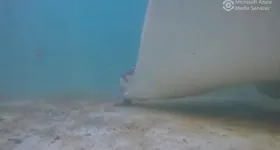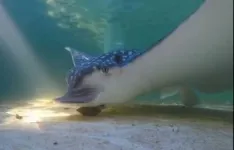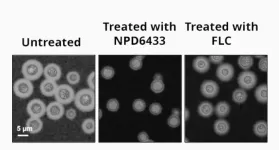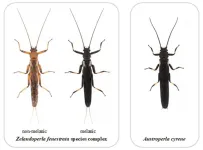Despite their protected status in Florida and designation as globally “endangered,” there is limited information in the United States available on critical components of the life history of the whitespotted eagle ray, such as their diet. Prior observations have described a location-specific yet variable diet consisting of hard clams in North Carolina, conch (queen and rooster) in the Caribbean region, calico clams in Bermuda and assorted marine snails in Mexico.
Figuring out the intricacies of a belly-full of food in marine predators is typically accomplished with visual observations. However, this is challenging for shell-crushing predators like the whitespotted eagle ray, which tends to winnow away the shells of their mollusk prey during feeding, concealing crucial evidence that scientists need to identify their shelled prey. Left behind in their gut is a conglomeration of mushy tissues of various colors and textures; this makes decoding their most recent meal a formidable task.
A new study by researchers at Florida Atlantic University’s Harbor Branch Oceanographic Institute, in collaboration with Mote Marine Laboratory & Aquarium, is the first to quantitatively describe the whitespotted eagle ray diet in U.S. coastal waters. By combining a visual-based, non-lethal gut content analysis with DNA barcoding, a tool used to rapidly identify species using small regions of the genome, they have uncovered the finer-scale feeding patterns of this species. These findings have important implications for both shellfish enhancement activities and species management.
Results, published in the journal Fishes, reveal that whitespotted eagle rays have a significantly broader diet than has been previously described and that their highly variable diet differs by region across the state of Florida.
While researchers did not find any commercially or recreationally important bivalves in their diet like hard clams, oysters or scallops, they did find very high proportions of cockles and wedge shells, neither of which have major commercial or recreational importance in Florida. However, rays also consumed predatory conchs known to kill important bivalves, underscoring the multi-faceted role that the whitespotted eagle ray plays in the food chain; they can feed directly on bivalves while also controlling the predators of these resources as well.
“The dietary data we obtained from our study not only fills ecological knowledge gaps for whitespotted eagle rays, but also provides important insight into how they interact with shellfish enhancement activities such as aquaculture and restoration efforts taking place in Florida’s coastal waters,” said Matt Ajemian, Ph.D., senior author, an associate research professor and director of the Fisheries Ecology and Conservation Lab at FAU Harbor Branch. “Our findings suggest rays can actually play a facilitative role at reducing predation threats from predatory snails on bivalve shellfish operations. However, this may depend on the size of the rays, as they appear to consume more bivalves at young age classes and incorporate more conchs and whelks into their diet as they grow. So, the capacity for the species to interact with the shellfish enhancement is likely complex and could depend on life stage and location.”
In total, researchers observed 33 unique prey items in the gut contents of 50 whitespotted eagle rays collected and released from four locations in Florida: Fort Pierce, Sebastian, St. Lucie and Sarasota. Contents also included hermit crabs, but it’s not clear if it was intentional or incidental because hermit crab tissues were found within the shells of gastropods consumed by the rays.
“Understanding the dietary preferences of whitespotted eagle rays also can offer valuable insights into the toxin pathways in ecosystems such as the Indian River Lagoon in the face of harmful algal blooms,” said Brianna Cahill, corresponding author, an FAU Harbor Branch marine science and oceanography graduate, and a research technician at Stony Brook University. “For example, Karenia brevis blooms are becoming more common off Sarasota, and toxins have been previously shown to transfer in both bivalve and gastropod prey identified in our study, which suggests that whitespotted eagle rays are likely exposed as well.”
Co-authors of the study are Ryan J. Eckert, a Ph.D. candidate at FAU Harbor Branch; Kim Bassos-Hull, a senior biologist at Mote Marine Laboratory & Aquarium; Thomas J. Ostendorf, a research technician; Joshua D. Voss, Ph.D., an associate research professor and executive director of NOAA’s Cooperative Institute for Ocean Exploration, Research and Technology; and Breanna C. DeGroot, a research coordinator in the Fisheries Ecology and Conservation Lab, all within FAU Harbor Branch.
Funding for this study was provided by the Mote Scientific Foundation, Georgia Aquarium, and the Indian River Lagoon Graduate Research Fellowship administered by the Harbor Branch Oceanographic Institute Foundation.
- FAU -
About Harbor Branch Oceanographic Institute:
Founded in 1971, Harbor Branch Oceanographic Institute at Florida Atlantic University is a research community of marine scientists, engineers, educators and other professionals focused on Ocean Science for a Better World. The institute drives innovation in ocean engineering, at-sea operations, drug discovery and biotechnology from the oceans, coastal ecology and conservation, marine mammal research and conservation, aquaculture, ocean observing systems and marine education. For more information, visit www.fau.edu/hboi.
About Florida Atlantic University:
Florida Atlantic University, established in 1961, officially opened its doors in 1964 as the fifth public university in Florida. Today, the University serves more than 30,000 undergraduate and graduate students across six campuses located along the southeast Florida coast. In recent years, the University has doubled its research expenditures and outpaced its peers in student achievement rates. Through the coexistence of access and excellence, FAU embodies an innovative model where traditional achievement gaps vanish. FAU is designated a Hispanic-serving institution, ranked as a top public university by U.S. News & World Report and a High Research Activity institution by the Carnegie Foundation for the Advancement of Teaching. For more information, visit www.fau.edu.
END








